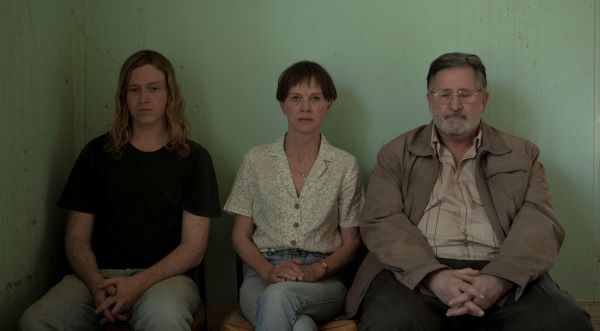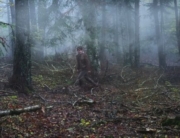In 1996, one of the darker chapters in Tasmania’s history occurred: the Port Arthur massacre, a mass shooting in which a young man named Martin Bryant killed 35 people. He received life sentences for each killing, and the incident sparked an overhaul in gun legislation in Australia, one which, in contrast to the United States, seems to have gone smoothly and without much opposition. Nitram, a new film from director Justin Kurzel and writer Shaun Grant, envisions the days leading up to the massacre from the killer’s point of view. The emphasis here is on understanding the context that led to the tragedy, without excusing either the killer or the crime.
We do not once hear him referred to as “Martin.” The one name we hear for him is “Nitram,” a slur I was not familiar with before watching this. There is something off about Nitram (Caleb Landry Jones), though it is unclear exactly what. A grown man, he has no driver’s license, he lives with his parents, loves to shoot off firecrackers, has a childish sense of humor, and no sense of boundaries. When trying to start a lawn mowing business, he essentially tries to force his way into an unwilling customer’s home. He is on some sort of antidepressant, and has trouble making friends and talking to people. He is also self-aware and knows others think he is strange.
His parents worry about him, as his behavior is erratic. Early on, his father (Anthony LaPaglia) catches him outside the schoolyard introducing children to firecrackers while they’re at recess. Dad has received a loan from a bank to purchase a gorgeous farm, which he hopes his son will run with him and therefore live safely away from others. His mother (Judy Davis), harsher and less patient, comes across as less optimistic.
Nitram, however, becomes friends with a wealthy, eccentric heiress named Helen (Essie Davis), who employs him as a handyman, buys him a car, tells him he looks like a movie star, and eventually welcomes him into her home, where she is surrounded by pets and sings along to Gilbert and Sullivan. His parents, especially his mother, are wary of this precarious-seeming relationship, but they recognize that they are powerless to intervene. Helen appears to have infinite tolerance and love for Nitram, until his interest in guns emerges and disturbs her.
Kurzel’s last film was the fascinating but uneven True History of the Kelly Gang, where he displayed an incredible talent for image and atmosphere. On this front, Nitram is outstanding. Suburban Tasmania, with its gorgeous vistas, well-kept buildings, desolate homes, and abandoned lots are brought to the screen vividly, and Kurzel’s eye for eerie images and tableaus, whether the rising of smoke or cats swarming in Helen’s dilapidated living room, unsettles the viewer as much as the events themselves.
There is also scarcely a single performance that is not striking. Not only does Jones’s Nitram convince in his loneliness, but Judy Davis beautifully captures the weariness, impatience, and intelligence of Mum, while LaPaglia conveys both compassion and depression. Many of the scenes between Jones and Essie Davis are especially striking, as they create both a weird tenderness and a sense of queasiness that radiate throughout the film.
Kurzel and Grant’s main objective, according to the press notes, was to understand how this horrible tragedy happened. Interestingly, this is where the film is most lacking, not in the sense that it doesn’t provide answers at all, but in that its answers are almost too obvious. Less than halfway, it is clear that Nitram is not well, that he has not been diagnosed accurately, that there aren’t any support systems for him, that his mother often holds him at arm’s length, that he is lonely and has endured relentless bullying, and, most importantly, that guns are easy to come by. While the events are no less horrifying, it is not difficult to see how these pressures could conspire to produce a mass shooter, so that, ultimately, the film isn’t very revealing. The second half is also so drawn out that this viewer found the relentless queasiness numbing rather than engaging.
In both of his recent films, Kurzel has shown admirable interest in getting to the bottom of the darker aspects of masculinity and with the legacies of violence. With more nuanced scripts in his hands, he may be able to go much further in the future.

















Leave A Comment